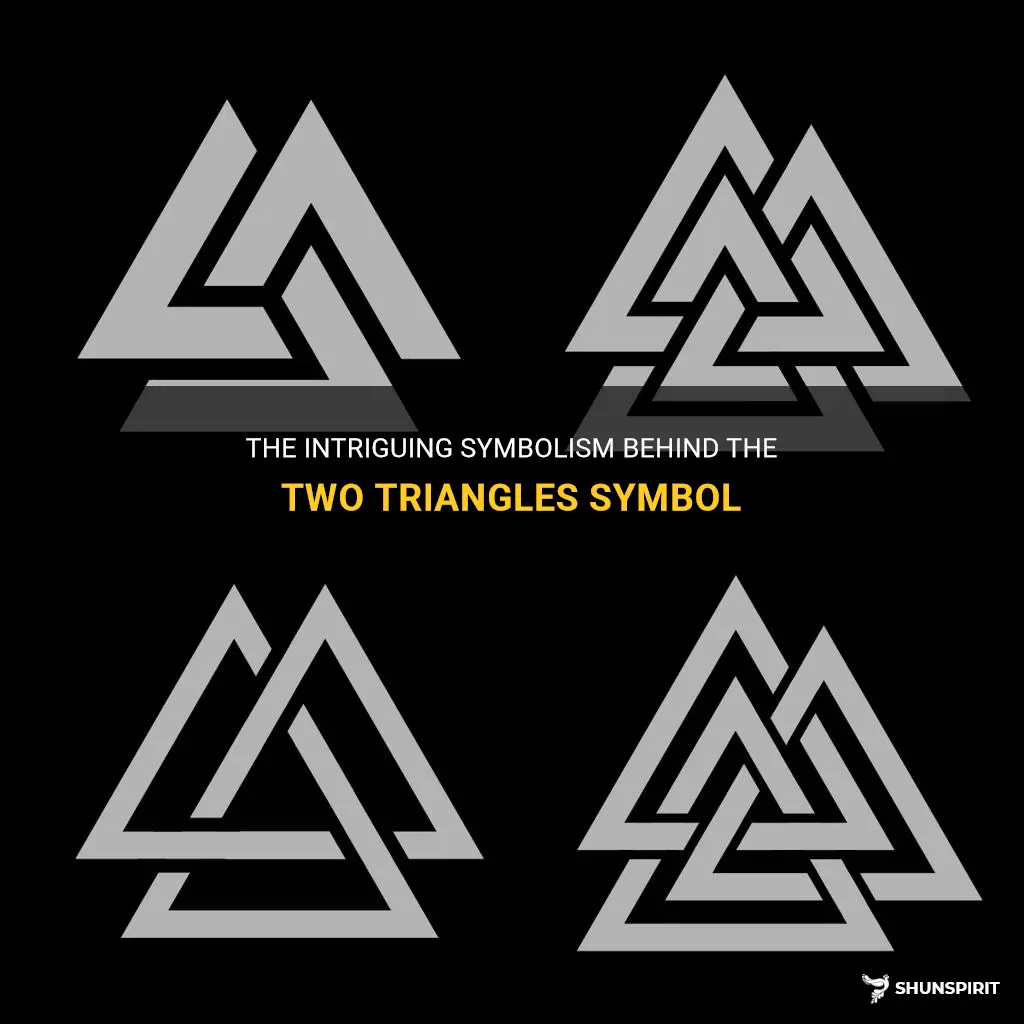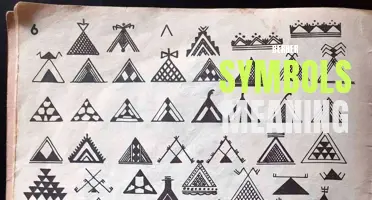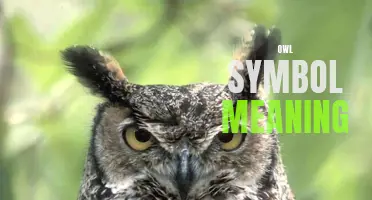
Triangles are geometric figures that are known for their stable and balanced structure. In many cultures and ancient traditions, triangles hold significant meaning and symbolism. They are often associated with different elements, aspects of life, and even spiritual concepts. The triangle symbol meaning differs from one culture to another, but they all share the common theme of representing harmony, balance, and the interconnectedness of things. Whether it's the sacred triangle in Christianity, the elemental triangle in alchemy, or the threefold nature of existence in Hinduism, the symbolism of triangles is as diverse as it is fascinating. Join us as we delve into the depths of triangle symbolism and explore the rich meaning that these shapes hold in various cultures and traditions.
What You'll Learn
- What is the meaning or symbolism behind the two triangles symbol?
- Are there different interpretations of the two triangles symbol in different cultures or religions?
- Is the two triangles symbol used in any specific fields or industries?
- How has the meaning of the two triangles symbol evolved over time?
- Are there any alternate names or terms for the two triangles symbol?

What is the meaning or symbolism behind the two triangles symbol?
The two triangles symbol has various meanings and symbolism depending on the context in which it is used. In general, the two triangles symbol is commonly associated with unity, balance, and harmony. It can also represent the duality of human nature or the connection between the physical and spiritual realms.
One of the most well-known variations of the two triangles symbol is the Star of David, which is the emblem of Judaism. This symbol is made up of two interlocking triangles, one pointing upwards and the other pointing downwards. The upward-pointing triangle represents the divine or spiritual realm, while the downward-pointing triangle represents the earthly or physical realm. Together, they symbolize the integration of these two realms and the pursuit of harmony between them.
In other spiritual traditions, the two triangles symbolize various concepts and principles. In Hinduism, the two triangles form a six-pointed star known as the Shatkona, which represents the union of divine masculine and feminine energies. This symbol is often associated with the Hindu deity Shiva and his consort Shakti, and it represents their harmonious union and the balance of creative and destructive energies in the universe.
In alchemy and esoteric traditions, the two triangles symbolize the union of opposites and the process of spiritual transformation. The upward-pointing triangle represents fire, the active masculine principle, while the downward-pointing triangle represents water, the passive feminine principle. Together, they represent the alchemical process of uniting and balancing opposing forces to achieve spiritual enlightenment or transcendence.
Additionally, the two triangles symbol can also be found in various cultural and religious traditions around the world. In Native American symbolism, the two triangles often represent the interconnectedness of the four elements - earth, air, fire, and water. In ancient Egyptian art, the two triangles can be seen in the hieroglyph for "wet" or "moist," symbolizing fertility and regeneration.
Overall, the two triangles symbol holds deep meaning and symbolism across different cultures and spiritual traditions. It represents the integration of opposites, the harmony between the physical and spiritual realms, and the pursuit of balance and unity in all aspects of life. Whether used in religious, spiritual, or cultural contexts, the two triangles symbol serves as a reminder of the interconnectedness and interdependence of all things.
Unveiling the Symbols and Meanings of St. Patrick's Day
You may want to see also

Are there different interpretations of the two triangles symbol in different cultures or religions?
The two triangles symbol holds significant meaning and can be interpreted differently across various cultures and religions. While the interpretation may vary, the overarching symbolism often represents opposing yet complementary forces, balance and harmony, or dualism. Let us explore some interpretations of the two triangles symbol in different cultural and religious contexts.
Judaism:
In the Jewish faith, the two triangles symbolize the Star of David, also known as the Shield of David. This symbol holds deep historical and religious significance, representing the unity of the Jewish people, the connection to the divine, and the harmony between the spiritual and material worlds. It is also associated with King David, the biblical figure, and his triumphs.
Hinduism:
In Hinduism, the two triangles form the Sri Yantra, a sacred geometric symbol representing the feminine and masculine energies of the universe. The upward-pointing triangle represents the masculine aspect, also known as Shiva, symbolizing strength, action, and divine consciousness. The downward-pointing triangle represents the feminine aspect, known as Shakti, symbolizing creativity, nurturing, and divine power. The union of these two triangles represents the unity and balance of the cosmos.
Alchemy:
In alchemy, the two triangles symbolize opposite yet complementary elements. The upward-pointing triangle represents fire or the active, masculine principle, while the downward-pointing triangle represents water or the passive, feminine principle. The union of these opposing forces represents the alchemical process of transformation and the pursuit of spiritual enlightenment.
Wicca and Paganism:
In Wicca and Pagan traditions, the two triangles symbolize the union of the God and the Goddess, representing the balance of masculine and feminine energies within nature and ourselves. It is also associated with the concept of duality and the interplay of light and dark, life and death, creation and destruction.
Buddhism:
In Buddhism, the two triangles symbolize the interdependence and harmony between wisdom and compassion. The upward-pointing triangle represents wisdom or prajna, signifying the pursuit of knowledge, understanding, and enlightenment. The downward-pointing triangle represents compassion or karuna, symbolizing love, empathy, and the desire to alleviate suffering.
Occult and Esoteric Traditions:
In occult and esoteric traditions, the two triangles form the hexagram or the Seal of Solomon. It is a powerful symbol representing the union of opposing forces and the mastery of the spiritual and material realms. It is associated with the balance of the elements and the integration of the macrocosm and microcosm.
In conclusion, the two triangles symbol can be interpreted differently across various cultures and religions, highlighting the diversity of beliefs and values. While the symbol represents opposing forces and duality, it also encompasses the idea of balance, harmony, and the interplay of energies. Understanding these different interpretations allows us to appreciate the depth and richness of symbolism in different cultural and religious contexts.
Unveiling the Enigmatic Meaning of the Greek Key Symbol
You may want to see also

Is the two triangles symbol used in any specific fields or industries?
The two triangles symbol, also known as the double triangle symbol, is a geometric pattern consisting of two equilateral triangles overlapping each other. This symbol has been used in various fields and industries throughout history and continues to hold significance today.
One of the most well-known uses of the two triangles symbol is in the field of alchemy. In alchemical symbolism, the symbol represents the union of opposites, often depicted as the union of masculine and feminine energies. It is a visual representation of the process of transformation and achieving balance between opposing forces.
In the field of psychology, the two triangles symbol is associated with the concept of integration. It represents the integration of the conscious and unconscious aspects of the psyche, as well as the integration of different aspects of the self. This symbol is often used in therapy and counseling to represent the journey of self-discovery and personal growth.
The two triangles symbol is also commonly used in mathematics and geometry. It is often used to represent congruence between two triangles or to denote the intersection of two lines. In geometry, the symbol is used to denote the concept of similarity, where two triangles have the same shape but may differ in size.
In addition to these fields, the two triangles symbol has also been used in various spiritual and religious contexts. It is often associated with the concept of the divine or higher consciousness. Some belief systems interpret the symbol as representing the union of duality and the ultimate unity of all things.
In recent years, the two triangles symbol has gained recognition and popularity as a symbol for the LGBTQ+ community. The symbol, often referred to as the "double male symbol," has been adopted by many individuals and organizations as a sign of solidarity and support for LGBTQ+ rights and inclusivity. It is often used in pride flags and other LGBTQ+ symbols, representing the celebration and acceptance of diversity.
Overall, the two triangles symbol holds significant meaning in various fields and industries. It represents concepts such as integration, transformation, congruence, and unity. Its versatility and universal appeal make it a powerful and timeless symbol that continues to be used and adapted in different contexts.
The Rich Symbolism and Deep Meanings of Hmong Symbols
You may want to see also

How has the meaning of the two triangles symbol evolved over time?
The two triangles symbol, also known as the Star of David or the Jewish Star, has a rich and complex history that has evolved over time. It is a significant symbol in Judaism and is often associated with Jewish identity and the State of Israel.
The origins of the symbol can be traced back to ancient times, although its exact meaning and significance have changed over the centuries. One theory suggests that the two triangles represent a union between the divine and the human, with the upward-facing triangle symbolizing the divine and the downward-facing triangle symbolizing the human. This interpretation is supported by the belief that the symbol represents the merging of two opposites, such as heaven and earth or male and female.
In early Jewish history, the two triangles symbolized the relationship between God and the Jewish people, with the upward-facing triangle representing God's protection and the downward-facing triangle representing the people's response and commitment to God's commandments. The symbol became associated with Jewish identity and was often used as a marker of Jewish graves.
During the Middle Ages, the two triangles symbol gained wider recognition as a symbol of Judaism. It appeared on synagogues, ceremonial objects, and Jewish documents, and was often used to distinguish Jews from non-Jews. However, it was not until the 17th century that the symbol became widely known as the Star of David.
In more recent history, the symbol took on a new significance with the establishment of the State of Israel. In 1948, the Star of David was included on the flag of Israel, becoming a national symbol of the Jewish people. It represents the Jewish people's connection to the Land of Israel and their struggle for independence and self-determination.
Today, the two triangles symbol continues to be a powerful and meaningful symbol for Jewish people around the world. It represents Jewish identity, unity, and resilience in the face of adversity. The symbol is often worn as jewelry or displayed on buildings, flags, and other objects as a sign of pride and solidarity with the Jewish community.
However, it is important to note that the meaning and significance of the two triangles symbol can vary among different individuals and communities. Some may attach religious or cultural significance to the symbol, while others may view it primarily as a national or political emblem. It is a symbol that continues to evolve and adapt to the changing times, reflecting the diverse experiences and perspectives of the Jewish people.
The Universal Dishwasher Safe Symbol: What Does It Mean?
You may want to see also

Are there any alternate names or terms for the two triangles symbol?
The two triangles symbol is a powerful and ancient symbol that has been used in various cultures and religions throughout history. It is often associated with concepts such as balance, duality, harmony, and spirituality. While it is commonly referred to as the "two triangles symbol," it is also known by several other names and terms across different traditions.
In Hinduism, the two triangles symbol is called the Sri Yantra or Sri Chakra. It is a sacred geometric pattern composed of nine interlocking triangles that form a central point called the Bindu. The Sri Yantra represents the union of the divine masculine and feminine energies, known as Shiva and Shakti. It is regarded as a powerful tool for meditation and is believed to bring abundance, peace, and spiritual awakening.
Another name for the two triangles symbol is the Star of David or the Seal of Solomon. In Judaism, it is considered a sacred emblem and is traditionally associated with King David and his lineage. The Star of David consists of two equilateral triangles, one pointing upward and the other downward, which are interconnected. It represents the connection between God and humanity, as well as the balance between different aspects of life, such as the spiritual and the material.
In alchemy and Hermetic traditions, the two triangles symbol is known as the hexagram or the Six-Pointed Star. It is formed by overlapping two equilateral triangles, one pointing upward and the other downward. The hexagram symbolizes the harmonious union of opposites, such as the elements of fire and water, and represents the concept of "as above, so below." It is widely used in magical practices and is seen as a symbol of divine wisdom and spiritual transformation.
The two triangles symbol can also be referred to as the Merkaba, particularly in New Age and metaphysical circles. The Merkaba is a three-dimensional star tetrahedron, composed of two interlocking triangular pyramids, one pointing upward and the other downward. It is believed to be a vehicle of light and consciousness, capable of transporting the individual's spiritual essence to higher realms and dimensions.
In conclusion, the two triangles symbol can be known by different names and terms depending on the cultural, religious, or spiritual context. These include the Sri Yantra, Star of David, Seal of Solomon, hexagram, and Merkaba. Each name reflects the unique significance and interpretation attributed to the symbol within a specific tradition. Regardless of the name, the two triangles symbol continues to fascinate and inspire people with its deep symbolism and universal themes.
Exploring the Symbolic Meanings behind Baby Brezza Symbols
You may want to see also
Frequently asked questions
The two triangles symbol, also known as the Star of David or the Jewish Star, is a significant symbol in Jewish culture and religion. It consists of two interlocking equilateral triangles, creating a six-pointed star. This symbol has been used for centuries and holds various meanings, including the unity of God and the Jewish people, the balance between the spiritual and the physical, and the connection between heaven and earth.
While the two triangles symbol originated in Jewish culture, it has also been adopted by other religions, cultures, and organizations. In recent times, it has become a symbol of Jewish identity and is often used to represent Judaism and Jewish communities worldwide. However, it is important to note that the use of this symbol outside of Judaism may have different meanings and connotations.
No, the two triangles symbol does not have any inherently negative connotations. However, like any symbol, it can be subject to interpretation and misuse. In some contexts, individuals or groups may use the symbol with negative intentions, such as promoting hate or discrimination. It is essential to consider the context and intent behind the use of the symbol when interpreting its meaning.
Yes, individuals of any faith or background can wear the two triangles symbol if they feel a personal connection to its meaning. Many people wear the symbol as a sign of solidarity with the Jewish community or as a way to express their own spirituality. However, it is important to approach the symbol with respect and understanding of its cultural and religious significance.
If you are planning to use the two triangles symbol in your artwork or design, it is crucial to be mindful of its cultural and religious significance. While the symbol may hold personal meaning to you, it is important to consider the potential impact and respect the symbol's roots in Jewish culture. It is always a good idea to research and educate yourself about the symbol's meaning and context before incorporating it into your work.







